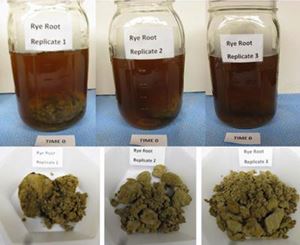|
Researchers Believe Fragipan Breakthrough Is On Horizon
PRINCETON, KY.
Soil scientists in the University of Kentucky College of Agriculture, Food and Environment are getting promising results from several treatments that appear to be breaking down the fragipan, a cement-like layer common in many soils in Western and Central Kentucky.
Soil fragipans exist in 2.7 million acres in Kentucky and in 50 million acres in the United States. In Kentucky, the average depth of the fragipan layer in the soil is about 20 to 24 inches. This results in a shallow soil that limits crops’ yield potential due to low water-holding capacity. This is especially true during dry growing seasons or droughts. These same soils are easily saturated with water in the winter, which limits yields on cool-season crops such as wheat.
Breaking down the fragipan would increase the soil depth and should significantly boost grain yields in the state, similar to the boost farmers received from implementing no-till production.
“Earlier work done by UK soil scientists found that soil erosion caused a loss of 3 to 6 percent of yield potential for every inch of lost topsoil,” said John Grove, UK soil scientist. “Additional subsoil rooting depth has a similar potential to increase yields, but it will depend on seasonal rainfall.”
Four years into the research project, Grove and fellow UK soil scientists Lloyd Murdock, Tasios Karathanasis and Chris Matocha have found that annual ryegrass and some chemical combinations appear to break down the fragipan.
“Annual ryegrass looks promising in the lab and in the greenhouse at breaking down the fragipan. It is beginning to show promise in the field,” Murdock said.
The idea to try ryegrass came from previous research conducted in southern Illinois by a former University of Illinois scientist.
“Mike Plumer thought he saw annual ryegrass doing something to fragipan soils in his cover crop research that would increase yields,” Murdock said.
In the lab, Karathanasis submersed chunks of fragipan in several different solutions, one of which was a ryegrass extract.
“Within two to four weeks we began to see the ryegrass extract break down the fragipan,” he said. “Not only does ryegrass have a deep root system that can penetrate the pan, but it also releases a chemical or chemicals that can help break it.”
UK soil scientists have planted annual ryegrass as a cover crop in grain fields followed by either corn or soybeans for the past three growing seasons with the fourth round now in the ground. The first year when annual ryegrass was followed by corn, there was no yield difference. The second year when it was followed by soybeans, there was a 25 percent yield increase in the soybeans. The third year, the researchers followed the ryegrass with soybeans again and there was a slight, but not significant, yield increase.
UK researchers traveled to Hamilton County, Illinois, to take soil samples from a field that had been planted in a ryegrass cover crop since 2000 and followed every year with no-till corn. Plumer had used a part of this field in some of his earlier cover crop studies.
They found the fragipan layer to be much deeper in the soil profile in the fields with ryegrass. More encouraging news came when the farmer told them about his yields.
“When the study started in 2000, the farmer’s yields were 15 bushels an acre below the county average. His fields are now averaging 30 bushels more per acre than the county average,” Murdock said. “We really do not know how well this field represents our situation in Kentucky, but this gives us significant encouragement that we are beginning to prove that annual ryegrass is effective and will give significant results with accumulative years of a ryegrass cover crop.”
As a result, UK researchers have established field trials this year on cooperating producers’ farms to document any changes this practice will make on a farm basis. Since it is expected that the effectiveness of the remediation is related to the number of years ryegrass is used, Kentucky farmers may want to begin to try a ryegrass cover crop on some or parts of their fragipan fields this fall.
“Ryegrass is our best shot based on what we know right now, but it’s going to take several years for farmers to get where they want to be,” Murdock said.
Researchers have also found that the chemicals potassium chloride, potassium sulfate, sodium fluoride and sodium nitrate may individually break down the fragipan, but are having difficulty getting the chemicals deep enough into the soil to be effective. The team continues to search for other effective and practical ways of remediating the fragipan.
Their early findings have been published in a paper in The Scientific World Journal, and it is available online at http://www.hindawi.com/journals/tswj/2014/276892/.
UK’s research project is funded by the Kentucky Small Grain Growers Association, Kentucky Soybean Board and the Kentucky Corn Growers Association. ∆

Top photo: Beginning of experiment.
Bottom: Fragipan clods begin to break after one
month in contact with ryegrass solution.
PHOTO: Tasios Karathanasis, UK soil scientist
|
|